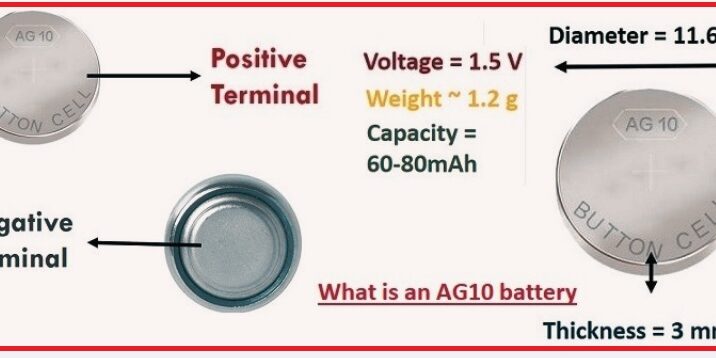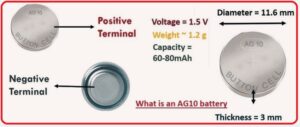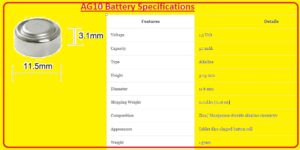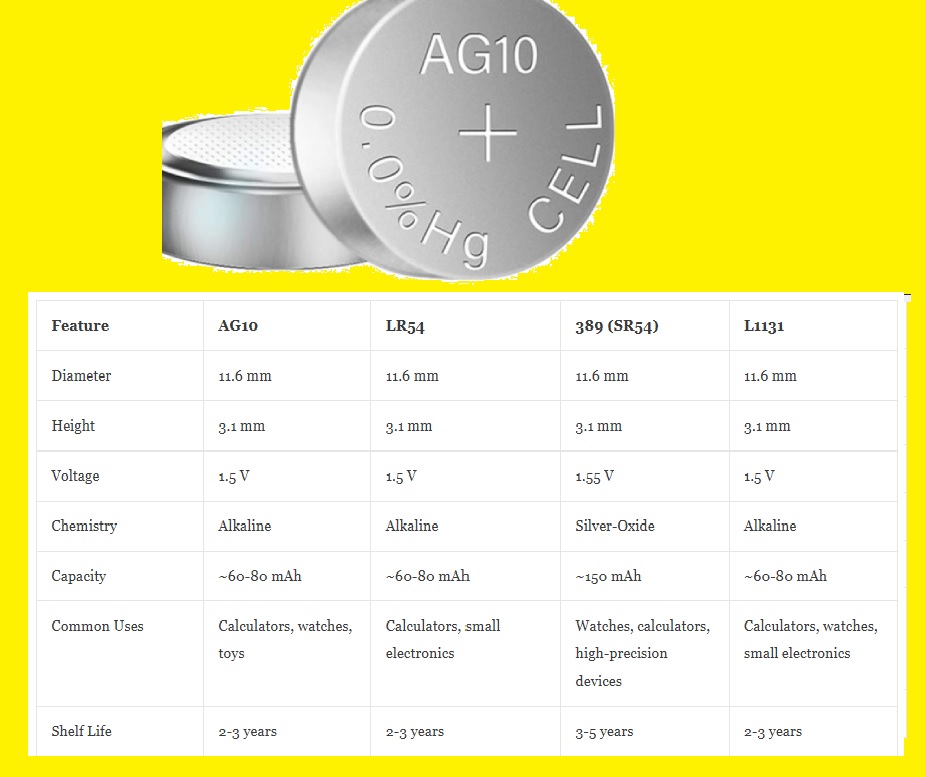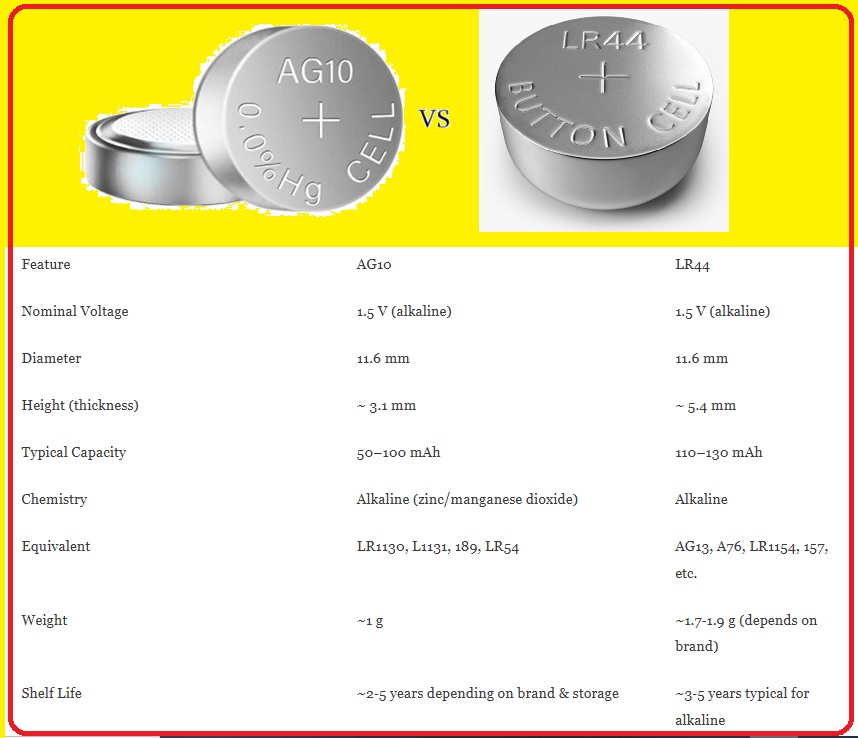The AG10 button battery is a small non-rechargeable battery. It is a primary cell that comes with alkaline chemistry. It’s working based on the chemical reaction occurring between two electrodes, zinc and manganese dioxide. This battery is part of small handheld devices such as watches, cameras, and calculators.
In this post, we cover details for AG10 battery features, dimensions, and related factors. So let’s get started.
What is an AG10 battery?
- The AG10 battery, also known as LR54, LR1130, and 389A, is a small, round-shaped alkaline battery used for small devices like toys, watches, and calculators.
- Its voltage value is 1.5 volts, and its capacity is 50 to 100 mAh.
- Its compact size makes it low weight, and the working temperature is -20°C to +60°C. Its working life is about 5 years, so provide stable voltage during discharge that is about 1.1 to 1.3 volts.
- The working of the AG10 battery is affected by different environmental factors like temperature.
- It operates well at about 21 degrees, since the safe range chemical reaction of the battery works safely, resulting in a stable current provided through the battery.
- Very low or high temperature affects battery’s working, with battery discharge and working life.
What does AG10 stand for?
The letters A and G used in the battery name AG10 show the chemical composition.
- Letter A defines alkaline chemistry, where a chemical reaction occurs to produce electrical energy through a zinc and manganese dioxide reaction.
- Letter G shows the shape and size of the battery
AG10 Battery Specifications
| Features | Details |
| Voltage | 1.5 Volt |
| Capacity | 50 mAh |
| Type | Alkaline |
| Height | 3.05 mm |
| Diameter | 11.6 mm |
| Shipping Weight | 0.01Lbs |
| Composition | Zinc/ Manganese dioxide alkaline chemistry |
| Appearance | Tablet disc-shaped button cell |
| Weight | 1 gram |
| Resistance | 15KΩ |
| Discharge | Continuous |
| Optimum Temperature | 21 degrees celsius |
| Equivalent | LR54, LR1130, L1131, V389, D390, GP89A |
AG10 Battery Equivalent
- It is a commonly available battery, and it can easily fit different devices and work reliably.
SR1130
- It provides high energy at output terminals, and this battery is used for high-drain devices for constant operation.
389A:
- It is stable and durable in nature and is a part for different calculators, watches, and small devices.
LR54:
- LR54 is compact in size and can easily connect to different electronic devices.
SR54:
- It is used for special-purpose devices since it provides high energy density with strong power.
G10:
- It has good working features and is used for different devices.
V10GA:
- It has stable voltage output and is considered a reliable working battery.
RW89:
- It provides constant working performance for different temperature conditions for continuous power features.
189:
- It works longer and is part of small devices like watches and other modules.
Read more: CR2025 Coin Battery, Features, Equivalent, & Applications
| Feature | AG10 | LR54 | 389 (SR54) | L1131 |
| Diameter | 11.6 mm | 11.6 mm | 11.6 mm | 11.6 mm |
| Height | 3.1 mm | 3.1 mm | 3.1 mm | 3.1 mm |
| Voltage | 1.5 V | 1.5 V | 1.55 V | 1.5 V |
| Chemistry | Alkaline | Alkaline | Silver-Oxide | Alkaline |
| Capacity | ~60-80 mAh | ~60-80 mAh | ~150 mAh | ~60-80 mAh |
| Common Uses | Calculators, watches, toys | small electronics | Watches, calculators, high-precision devices | watches, small electronics |
| Shelf Life | 2-3 years | 2-3 years | 3-5 years | 2-3 years |
| Discharge Rate | Low-drain | Low-drain | Low to moderate | Low-drain |
LR1130 vs AG10 Batteries
- These two batteries come with the same diameter, that can easily fit for different-sized batteries. These two come with different thicknesses, affecting their uses and working.
- LR1130 and AG10 are used for small electronic devices like watches and calculators, so they are known as compact design batteries.
- The AG10 battery thickness is 3.1 mm, so it can connect limited spaces.
- LR1130 is comparatively thick and used for devices where high capacity is needed. This high-thickness feature increases the working life of the battery; as a result, connected devices work longer.
Alkaline and Silver Oxide Equivalents
Voltage Output:
Alkaline (AG10):
- Its output voltage is 1.5 volts, and voltage reduces when the battery discharges normally for high-drain conditions.
Silver Oxide (SR1130, V389):
- Output voltages are 1.55 volts, which gives high stability for high-drain devices. Its voltage is constant during the complete discharge cycle.
Capacity
Alkaline:
- It has a low capacity of about 50 to 100 mAh, and the shelf life is two to five years. Its capacity reduces quickly with high drain.
Silver Oxide:
- This battery has a high capacity of 80 to 11 mAh and a longer working life, in the range of three to seven years, according to manufacturers. They were used where stable power was needed.
AG10 Battery Applications
Watches:
- This battery is used for analog and digital watches for a longer working life.
Calculators
- It is best bestfor calculators since they need low power for working.
Toys:
- It is also part of small toys that move and produce sound.
Laser Pointers:
- It is also part of a laser pointer for their functions.
Medical Devices:
- different power-based devices such as glucose monitors and digital thermometers, since they needed constant power
Remote Controls:
- TV remote controls and other devices’ remotes use this battery.
Flashlights:
- Flashlights also work by using an AG10 battery.
Security Systems:
- Backup power for different security systems is needed; this battery provides continuous power when outages occur.
Memory Backup:
- It is also part of devices that need memory, like clocks and electronics.
Features of AG10 Battery
The main features and advantages of the AG10 battery are as
Compact Size:
- The AG10 battery comes in a small form factor with an 11.6 mm diameter and 3.1 mm thickness, so it is used for compact devices like watches, calculators, and small toys.
Voltage Output:
- Its nominal voltage is 1.5 volts, so an AG10 battery provides constant power during its working life and reliable operations for devices where constant energy is needed.
Long Shelf Life:
- It has a low self-discharge rate, so it retains charge for longer durations. In proper storage conditions, an AG10 battery works for about 3 years without losing capacity.
Energy Density:
- The AG10 battery stores more energy in a small structure compared to others, so it is preferred for low-power uses.
Temperature Range:
- Its working range is -20°C to +60°C, which helps it to operate in different conditions.
Cost-Effective:
- It is a low-cost and easily accessible battery, so it is an economical option for users and manufacturers.
Easy to install
- Its installation is an easy process, and we can put it in any device easily.
Maintenance:
- AG10 is a non-rechargeable battery that needs no maintenance and can be easily used in different devices.
Safety:
- The AG10 battery is designed such that it avoids leakage and other damages, which makes its operation safe for different medical devices.
Internal Resistance
- Internal efficiency has an impact on the AG10 battery. If internal resistance is low, current easily flows since no hindrance for electric energy occurs. It converted into electrical energy that increases overall efficiency and device working performance.
Discharge Characteristics of AG10 Battery
AG10 VS LR44
Read related post:LR44 VS SR44: Is SR44 the Same as LR44
| Feature | AG10 | LR44 |
| Nominal Voltage | 1.5 V (alkaline) | 1.5 V (alkaline) |
| Diameter | 11.6 mm | 11.6 mm |
| Height (thickness) | ~ 3.1 mm | ~ 5.4 mm |
| Typical Capacity | 50–100 mAh | 110–130 mAh |
| Chemistry | Alkaline (zinc/manganese dioxide) | Alkaline |
| Equivalent | LR1130, L1131, 189, LR54 | AG13, A76, LR1154, 157, etc. |
| Weight | ~1 g | ~1.7‑1.9 g |
| Shelf Life | ~2‑5 years depending on brand & storage | ~3‑5 years typical for alkaline |
| Use | Good when a thinner battery is needed; | preffered When more capacity is needed and height is not an issue |
| Interchangeability | not interchangeable with LR44 because AG10 is much thinner; | LR44 may thick to replace AG10 in tight battery slots |
How to install an AG10 battery
- For installation of an AG10 battery, first of all, find the correct direction of the positive and negative terminals for accurate working and damage to the device.
- The flat side of the battery normally has positive terminals, and the side that is circular in shape is negative.
- For battery installation, first make sure the terminals have the accurate polarity of the device.
- that are shown as + and – symbols. So confirm that the battery is accurately aligned with these symbols; if the polarity is reversed, it can cause damage to the circuit.
- During battery connection with the device, also avoid damage to any part of the device in the compartment.
- This connection needs to be confirmed before the battery is connected to the device.
Are AG10 and 357 batteries the same?
- AG10 and 357 batteries have some features in common but are not directly interchangeable due to some differences.
- The AG10 is an alkaline battery with a nominal voltage of 1.5 volts and a capacity of 50 to 90 mAh; its size is 11.6 mm, and its thickness is 3.1 mm. It is used for toys, calculators, and watches.
- The 357 battery has a silver oxide battery with a voltage of 1.55 volts and a capacity of 150 to 170 mAH.
- Its diameter is 11.6 mm, and its thickness is 5.4 mm. 357 batteries are employed for medical components, cameras, and watches.
- different features make these non-interchangeable
| Parameter | AG10 | 357 (SR44) |
| Chemistry | Alkaline (zinc/manganese dioxide) | Silver‑oxide (Ag₂O / Zn) |
| Nominal Voltage | 1.5 V | 1.55 V (higher |
| Diameter | 11.6 mm | 11.6 mm |
| Height / Thickness | ~ 3.1 mm | ~ 5.4 mm |
| Capacity | Depends on brand, often lower | Higher than AG10 under similar loads |
| Voltage Stability | Alkaline cells tend to have a sloping discharge — voltage drops gradually under load | Silver‑oxide cells maintain a more stable voltage output |
| Shelf Life | good alkaline, but subject to leakage or voltage drop over time | better, |
| Interchangeability | thin height (~3.1 mm), it’s used in devices with limited depth | it is thicker (~5.4 mm), in many devices, it may not physically fit where AG10 is used |
| Use Cases / Strengths | Good for very low-profile / | Preferred voltage‑sensitive devices |
| Limitations | Lower energy capacity; | not fit into shallow compartments; more expensive due to silver content |
Are AG10 and AG13 batteries interchangeable?
- AG10 and AG13 batteries have some of the same features but are not interchangeable. These two batteries are alkaline batteries, and the voltage is 1.5 volts.
- The AG10 height is 3.1 mm, and the AG13 is 5.4 mm in thickness. This difference affects their interchanging features.
- AG13 has a high energy output, which is 150 to 170 mAh, and the AG10 capacity is 50 to 90 mAh, so AG13 is good for high-power devices like calculators and toys.
FAQs AG10 Batteries
What are the uses of AG10 batteries?
- It is used in small devices like calculators, toys, laser pointers, and key fobs. It is preferred since it has a compact size and high power.
What is the working life of AG10 batteries?
- working life of a battery based on the working of devices. for low-drain devices ag10 battery work for more than one year. In high-drain devices, it operates for some months.
Can AG10 batteries be replaced with other battery types?
- Yes, many replacement batteries of AG10 have the same size and voltage. Equivalent batteries of AG10 are LR54, 389, and L1131 batteries. Either they can canhavesome difference in discharge rates and capacity but can be replaced
What is the difference between AG10 and AG13 batteries?
- The basic differences are as
- The AG13 battery is thick and comes with a high capacity compared to the AG10 battery. These two have the same diameter, and the nominal voltage is 1.5 volts.
| Feature | AG10 Battery | AG13 Battery |
| Diameter | 11.6mm | 11.6mm |
| Thickness | 3.1mm | 5.4mm |
| Nominal Voltage | 1.5v | 1.5v |
| Capacity | Lower (than AG13) | Higher (than AG10) |
How to check the power of an AG10 battery?
- Mostly devices no integrated system for finding the AG10 battery’s remaining charge. If your devices stop working, that means they need replacement. voltage measured using a certain battery tester
Are AG10 batteries safe?
- AG10 batteries normally work safely if handled accurately and disposed of after use. It follows safety details for avoiding leaks and connections with corrosive materials. Using accurate battery devices can prevent any damage.
What is the shelf life of an AG10 battery?
- In dry and cool conditions, the AG10 battery works for 2 2to 3 times longer. Older batteries can affect the work. To maintain the tool working at its most accurate, use a new battery.
Are AG10 and 357 batteries the same?
- The AG10 and 357 batteries are different but have some features in common. AG10 and 357 have 1.5 volts with different chemistry and capacity. 357 provides 170 mAh capacity, and AG10 has 150 mAh.
Is LR44 the same as AG10?
- No, the LR44 battery is an alkaline battery with dimensions of 11.6 x 5.4 mm, and the AG13 has dimensions of 11.6 x 3.1 mm.
